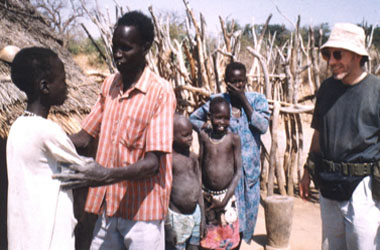Sudan


Sudan |
|
 |
|
The diversity of Islamic points of view in the North, and the virtual absence of Islam in the South, are hidden by Sharia law, which was imposed on the entire country by President Nimeiri in 1983. The current Khartoum government wants to bring the non-Muslim Black South in line with Sharia law, laid down and interpreted by conservative Muslim clergy. The Black animist and Christian South remembers many years of slave raids by Arabs from the north and east and resists Muslim religious rule and the perceived economic, cultural, and religious expansion behind it.
In April 1996, UN Special Representative for the Sudan, Gaspar Biro, reported "an alarming increase...in cases of slavery, servitude, slave trade, and forced labor." In June 1996, two reporters from the Baltimore Sun illegally visited the Sudan. They produced a series of articles in the Sun called "Witness to Slavery," in which they documented slavery in the Sudan. In fact, they bought two young slaves and set them free.
The debate has been going on since before Independence. Southerners at various times have proposed total separation, federation, or a unified secular state with freedom for all minorities. This struggle has been the fuel for two civil wars, the first ending in 1972 with a proposed federation. That solution dissolved into a second war in the mid-1980s, with disastrous human rights violations continuing on both sides.
War and famine have affected the traditional systems and laws for protecting women's rights, and the condition of women and girls has worsened. In the South, half the women refugees are widows. Population displacement has increased prostitution, rape, and sexually transmitted diseases. Child labor is another form of abuse in the Sudan, and female children are forced into early marriages, which endanger their health
Mauritania
Mauritania is southwest of Algeria, south of the Western Sahara, west of Mali, and north of Senegal. It has a 700-kilometer coastline on the Atlantic Ocean. The northern two-thirds of the country is part of the Sahara desert.
Slavery, racial division, human rights abuses and environmental degradation.
Mauritania's economy is based on agriculture, livestock, fishing, and mining. The country has huge mineral potential in copper, phosphates, and petroleum. Deposits of tungsten and uranium have also been identified. Iron ore reserves are estimated at 200 million tons with a high ferrous content of 65 percent to 70 percent.
Historically, Mauritania was inhabited by Black Africans. The region was the setting for advanced West African civilizations. An influx of Arabs from the north during the thirteenth, fourteenth, and fifteenth centuries forced settled Black communities south toward the Senegal River. In the 1850s the French encroachment from the south isolated Black Mauritanians between the French and the Arabs in the north.
The continuing crisis in independent Mauritania stems from its arbitrary creation by colonial France when France allowed Mauritania to become independent in 1960. Since then, it has been plagued by violent ethnic strife, the continuing practice of slavery and civilian/military rule, compounded by ecological degradation resulting from prolonged drought and desertification.
Yes! Slavery has persisted in 1998. In ancient times slavery was common in Mauritania. It became part of armed conflict between ethnic or political groups. Slavery continued among these populations in Mauritania through the eighth century, coming under Islamic authority. From this point forward, only Black Africans have been enslaved in Mauritania.
Slavery was first abolished in Mauritania by its colonizer, France, in 1905. The second abolition was implied in the new constitutin of Mauritania after France granted the country's independence in 1961. The third occurred when Mauritania joined the United Nations in October 1961. The fourth time abolition of slavery was proclaimed was in 1981 by the Military Committee of National Salvation. Article Two of the 1981 ordinance granted compensation to slave holders. However, although they were granted compensation, the language was so ambiguous that it was unclear where they money was to come from, and there was no provision for enforcement. That situation has lasted until today. Most slave masters continue to hold slaves, arguing that they must be compensated before they free their slaves.
In 1982, the London-based Anti-Slavery Society estimated that there were 400,000 slaves still held by Arab Mauritanians. In June 1994, the American Anti-Slavery Group and Amnesty International claimed that 90,000 Blacks still live as "the property" of slaveholders. They also reported that 300,000 freed slaves continued to serve their former masters because of psychological or economic dependence. In February 1996, an AFSC staffer visiting Mauritania videotaped recently freed slaves and heard anti-slavery leader Bobacar Messaoud estimate that nearly half the population continues to be either enslaved or in slave-like relationships.
Traditional forms of mistreatment of women continue, both in urban and rural areas. It consists of forced feeding of adolescent girls (gavage) and female genital mutilation. In gavage, brutal force is used to fatten young women so they will be more acceptable to men. Women in Mauritania usually do not seek legal redress, but rely on family and ethnic group members to intervene.
The government relies on foreign donors for immunization for diseases. It also does not require attendance at school. Nor does the government enforce existing child labor laws, and children perform much of the families' needed labor. There are reports of parents, in exchange for money, sending their children abroad to work.